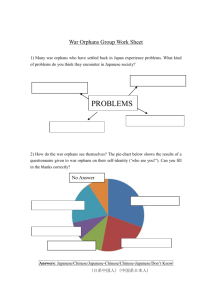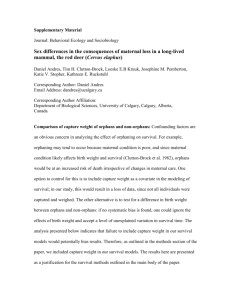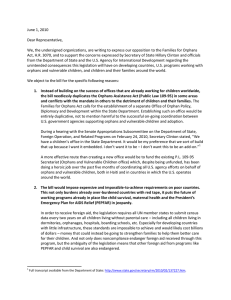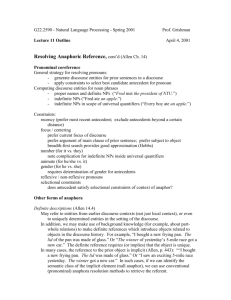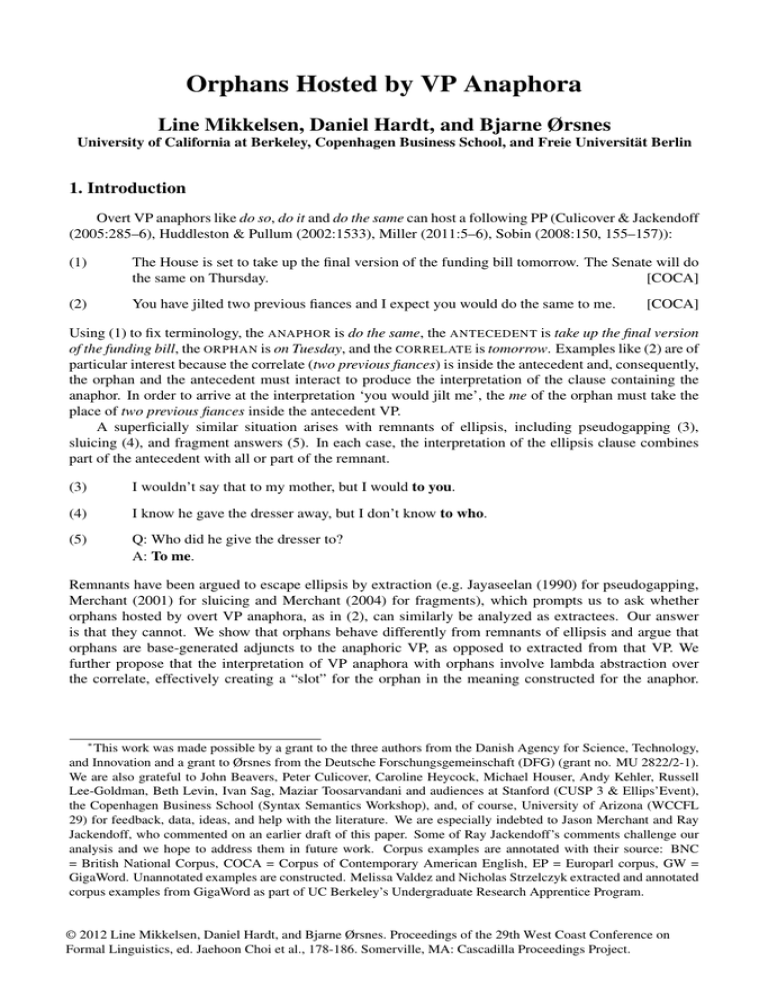
Orphans Hosted by VP Anaphora
Line Mikkelsen, Daniel Hardt, and Bjarne Ørsnes
University of California at Berkeley, Copenhagen Business School, and Freie Universität Berlin
1. Introduction
Overt VP anaphors like do so, do it and do the same can host a following PP (Culicover & Jackendoff
(2005:285–6), Huddleston & Pullum (2002:1533), Miller (2011:5–6), Sobin (2008:150, 155–157)):
(1)
The House is set to take up the final version of the funding bill tomorrow. The Senate will do
the same on Thursday.
[COCA]
(2)
You have jilted two previous fiances and I expect you would do the same to me.
[COCA]
Using (1) to fix terminology, the ANAPHOR is do the same, the ANTECEDENT is take up the final version
of the funding bill, the ORPHAN is on Tuesday, and the CORRELATE is tomorrow. Examples like (2) are of
particular interest because the correlate (two previous fiances) is inside the antecedent and, consequently,
the orphan and the antecedent must interact to produce the interpretation of the clause containing the
anaphor. In order to arrive at the interpretation ‘you would jilt me’, the me of the orphan must take the
place of two previous fiances inside the antecedent VP.
A superficially similar situation arises with remnants of ellipsis, including pseudogapping (3),
sluicing (4), and fragment answers (5). In each case, the interpretation of the ellipsis clause combines
part of the antecedent with all or part of the remnant.
(3)
I wouldn’t say that to my mother, but I would to you.
(4)
I know he gave the dresser away, but I don’t know to who.
(5)
Q: Who did he give the dresser to?
A: To me.
Remnants have been argued to escape ellipsis by extraction (e.g. Jayaseelan (1990) for pseudogapping,
Merchant (2001) for sluicing and Merchant (2004) for fragments), which prompts us to ask whether
orphans hosted by overt VP anaphora, as in (2), can similarly be analyzed as extractees. Our answer
is that they cannot. We show that orphans behave differently from remnants of ellipsis and argue that
orphans are base-generated adjuncts to the anaphoric VP, as opposed to extracted from that VP. We
further propose that the interpretation of VP anaphora with orphans involve lambda abstraction over
the correlate, effectively creating a “slot” for the orphan in the meaning constructed for the anaphor.
∗
This work was made possible by a grant to the three authors from the Danish Agency for Science, Technology,
and Innovation and a grant to Ørsnes from the Deutsche Forschungsgemeinschaft (DFG) (grant no. MU 2822/2-1).
We are also grateful to John Beavers, Peter Culicover, Caroline Heycock, Michael Houser, Andy Kehler, Russell
Lee-Goldman, Beth Levin, Ivan Sag, Maziar Toosarvandani and audiences at Stanford (CUSP 3 & Ellips’Event),
the Copenhagen Business School (Syntax Semantics Workshop), and, of course, University of Arizona (WCCFL
29) for feedback, data, ideas, and help with the literature. We are especially indebted to Jason Merchant and Ray
Jackendoff, who commented on an earlier draft of this paper. Some of Ray Jackendoff’s comments challenge our
analysis and we hope to address them in future work. Corpus examples are annotated with their source: BNC
= British National Corpus, COCA = Corpus of Contemporary American English, EP = Europarl corpus, GW =
GigaWord. Unannotated examples are constructed. Melissa Valdez and Nicholas Strzelczyk extracted and annotated
corpus examples from GigaWord as part of UC Berkeley’s Undergraduate Research Apprentice Program.
© 2012 Line Mikkelsen, Daniel Hardt, and Bjarne Ørsnes. Proceedings of the 29th West Coast Conference on
Formal Linguistics, ed. Jaehoon Choi et al., 178-186. Somerville, MA: Cascadilla Proceedings Project.
179
In support of this analysis we show that the position of the correlate is syntactically unconstrained, as
expected if the correlate is only identified semantically as the target of lambda abstraction. On the other
hand, not all orphans are possible with all antecedent VPs and we tentatively propose that this is due to a
pragmatic requirement that an orphan can be interpreted as what the hosting clause is about (in the sense
of Reinhart (1981)).
We end our paper with a comparison of our analysis to the constructional analysis of orphans offered
by Culicover & Jackendoff (2005) and some implications of our claims for recent attempts to unify
ellipsis and overt anaphora.
2. Orphans vs. remnants of ellipsis
Despite their surface similarity, there are two striking differences between orphans and remnants
of ellipsis. The first difference concerns the range of syntactic categories allowed, the second the
determination of the preposition used in a PP orphan or remnant.
As illustrated by the examples in (6)–(11), there is no inherent category restriction on remnants of
ellipsis:
(6)
I wouldn’t say that to my mother, but I would to you.
[PP]
(7)
You might not believe me, but you will Bob.
[DP]
(8)
I know she’s pretty tall, but I don’t know how tall.
(9)
Q: Is he tired or just lazy?
A: Tired.
[AP]
Q: What did he say?
A: That we should go ahead without him.
[CP]
(10)
(11)
[DegP]
Robin will bet an entire fortune that the Mets will win the pennant, and Leslie will that the
Braves will win.
[CP, from Culicover & Jackendoff (2005:294)]
In contrast, orphans must be PPs:
(12)
You have jilted two previous fiances and I expect you would do the same to me.
[PP]
(13)
* You have jilted two previous fiances and I expect you would do the same me.
[DP]
(14)
* He built a small box to keep his CDs in and I did the same large.
[AP]
(15)
* The guide came over and told me that I had to stay behind the red line and then the guard did
the same that I had to stop taking photos.
[CP]
In the first two examples the correlate is a DP, two previous fiances, and yet the orphan must be a PP
(12), not a DP (13). An AP orphan is impossible in (14), despite the presence of an adjectival correlate
(small). Similarly, a CP orphan is impossible in (15), despite the availability of a CP correlate in the
antecedent.
For PP remnants, the identity of the preposition is determined by the antecedent. This is shown for
pseudogapping in (16), where the antecedent verb rely selects for the preposition on and that is the only
preposition allowed in the remnant. In (17) and (18) the antecedent verb look selects a PP headed by at
and the sluice and fragment require at as well.
(16)
I wouldn’t rely on Harvey, but I would on/*to/*with Frank.
(17)
She’s looking at something, but I don’t know at/*to/*for what.
(18)
Q: What are you looking at?
A: At/*To/*For this little ant crawling over my cell phone.
180
In orphans, the preposition is not determined by the antecedent, but loosely restricted by the thematic
relation of the orphan to the VP hosting it. As far as we can tell, only three prepositions are used to
introduce orphans with VP-internal correlates: for, to, and with.
Benefactive orphans are typically introduced by for, as in (19), where Turkey would benefit from
being given the prospect of membership, and (20), where Angola would benefit from peace brought on
by Mandela magic.
(19)
Why should we not give Ukraine the prospect of membership when we would do the same for
Turkey.
[EP]
(20)
World powers are counting on the “Mandela magic” which helped bring peace to South Africa
to do the same for civil war-torn Angola, . . .
[GW]
Patient orphans are typically introduced by to, as noted by Huddleston & Pullum (2002:1533) and
Culicover & Jackendoff (2005:285), and as illustrated in (21) and (22) below. In each of these, the
event denoted by the anaphor involves a, rather dramatic, change of state in the referent of the orphan
NP: a neck being snapped off in (21) and a person being blown up with plastic explosives in (22).
(21)
Which of us on finding our car aerial snapped off by a vandal have not momentarily wanted
to do the same to his neck?
[BNC]
(22)
Forget the plastic explosive; certainly it would blow a hole in those walls, but it would do the
same to Ted.
[COCA]
Finally, with is often used to introduce themes, as in (23) and (24), and as noted by Culicover &
Jackendoff (2005:285) (see also Jackendoff (1990:161)):
(23)
Robert Pelletreau, the assistant secretary of state for Near Eastern affairs, told a congressional
panel that North Korea has sold medium- range SCUD missiles to Iran and Syria and that it
could do the same with the Rodong.
[GW]
(24)
By penalising the pirating of Canal+ decoders, we effectively created a monopoly on
reception. And some people would like to do the same with the Internet.
[EP]
The nature and strength of these correlations between thematic role and preposition choice need to
be investigated further. The important point for our argument is that the choice of preposition is not
determined by the antecedent. The data above show this in two ways. In (19), (21) and (23), the
antecedent doesn’t provide a source for the orphan preposition, since the correlate is a bare DP. In
examples (20), (22) and (24), the correlate is introduced by a preposition, but in each case that preposition
differs from the one introducing the orphan: to vs. for in (20), in vs. to in (22), and on vs. with in (24).
This is in stark contrast to the examples in (16)-(18), where the correlate and orphan prepositions must
be identical.
Extraction analyses of remnants of ellipsis are schematized in (25)-(27):
(25)
You might not believe me, but you will [VP [VP believe ti ] Bobi ]
(26)
I know she’s pretty tall, but I don’t know [CP how talli [TP she is ti ]] (Merchant, 2004:665)
(27)
Q: Is he tired or just lazy?
A: [FP Tiredi [TP he is ti ]]
(Jayaseelan, 1990:65)
(Merchant, 2004:675)
In pseudogapping (25) the remnant undergoes Heavy NP-shift (Jayaseelan, 1990) and thereby survives
VP ellipsis. In sluicing (26) the remnant undergoes wh-movement and thereby escapes TP-ellipsis.
Finally, in (27), the remnant undergoes focus fronting prior to clausal ellipsis. The particular movements
that bring the remnant outside the scope of ellipsis are different in each case—and subject to some debate,
especially in the case of pseudogapping—but the analyses are alike in assuming that the remnant starts
out inside a syntactically articulated target of ellipsis (a VP in (25), a TP in (26) and (27)), and moves out
181
of that phrase prior to ellipsis. This type of analysis straightforwardly explains why there is no inherent
category restriction on the remnant of ellipsis. Whatever restrictions are observed would be attributed to
subcategorization and restrictions on the particular movement that brings the remnant outside the ellipsis
site.
The fact that remnant PPs have their preposition determined by the antecedent also follows naturally
from the extraction analysis. Consider the analysis in (28) of the pseudogapping example in (16) above:
(28)
I wouldn’t rely on Harvey, but I would [VP [VP rely ti ] [on Frank]i ].
The remnant preposition is on because the remnant originates as the complement of rely, which selects
for a PP headed by on. The identity requirement on ellipsis forces identical antecedent and target verbs,
which in turn forces identical prepositions for PP orphans and correlates. In sum, the extraction analysis
of remnants accounts for the lack of category restrictions on these and the fact that PP remnants use the
same preposition as their correlate. Orphans differ from remnants in both respects (orphans are always
PPs and orphans don’t inherit their preposition from the antecedent) and we thus conclude that orphans
are not extractees.
We propose, instead, that orphans are base-generated adjuncts to the anaphoric VP, as in (29).
(29)
VP
XX
XX
X
PP
VP
"b
Q
Q
"
b
DP
DP
V
P
Q
Q
CC
do the same to/with/for
X
Under this analysis, the requirement that the orphan be a PP falls under the general requirement of
English syntax that adjuncts to VP be PPs.1 Secondly, the orphan may use a different preposition than
the correlate (as in (20), (22) and (24)) because the orphan is an adjunct and as such not selected for by
a head which could impose restrictions on the choice of preposition.
Three additional observations support the adjunct analysis. First, the orphan is optional, which is a
characteristic property of adjuncts:
(30)
He folded up his jacket and sat on it. I did the same (with mine).
Secondly, the prepositions used to introduce orphans are all contentful prepositions and do not include
the case-marker of, which is used widely in complement PPs (the election of Barack Obama, the father
of the bride, fond of chocolate, think of the possibilities). Finally, orphans allow the same range
of prepositions wherever they occur, including pseudoclefts (Jackendoff (1990:125) and (31) below),
predicate questions (32), and as-clauses (the data in (33)–(35) come from Lee-Goldman (2011)):
(31)
What she did to/with/for Harvey was edit his manuscript.
(32)
What did you do to/with/for Harvey?
(33)
She’s not above ribbing someone, as she did to me in calling, “Nice face plant Larry. You
might work on avoiding that next time.”
(34)
Or perhaps she got the name of the Chinese American Citizen’s Alliance close, but not quite
right, as she had with the Arizona Historical Society’s library?
(35)
Yes, just as Bruno claimed for an infinite universe, this finite model has “no center nor edge”.
It is also worth noting that the adjunct analysis carries over to orphans with VP-external correlates like
on Thursday in (1), repeated in (36) below. The difference between orphans with external correlates and
orphans with internal correlates has to do with interpretation, not syntax.
1
English does allows a fairly restricted set of DP adjuncts with temporal (I saw him this morning.) and manner
(Don’t talk that way!) interpretations. Adjunct clauses (. . . because/when/if/even though he left.) are adjoined above
VP, so their syntactic category is irrelevant for our claim.
182
3. Interpreting orphans
Interpretation of orphans with VP-external correlates, as in (36), is straightforward: the anaphor
takes its meaning from the antecedent VP and that meaning is combined with the temporal meaning of
the orphan PP in the normal way to produce the interpretation ‘take up the final version of the funding
bill on Thursday’.
(36)
The House is set to [VP take up the final version of the funding bill] tomorrow. The Senate will
do the same on Thursday.
Orphans with VP-internal correlates present an interesting challenge for the semantic interpretation of
the VP anaphor and its orphan: part of the meaning comes from the antecedent, but, crucially, part of the
meaning of the antecedent must be kept out to make room for the orphan. We propose that the presence
of the orphan adjunct forces abstraction over the correlate in the antecedent, creating a “slot” for the
orphan in the meaning reconstructed for the anaphor. This follows the general approach of Dalrymple
et al. (1991), in which one or more parallel elements are determined, and then each parallel element is
lambda abstracted over. Our analysis makes use of three well-established semantic mechanisms: lambda
abstraction, semantic reconstruction and functional application. Later in this section we consider, and
reject, syntactic movement as an alternative to lambda abstraction, but first we illustrate our proposal by
analyzing (37), which is a modified version of (23) above:
(37)
North Korea could sell SCUD missiles to Iran and it could do the same with the Rodong.
The antecedent is sell SCUD missiles to Iran, the correlate is SCUD missiles, and the orphan is the
Rodong (another type of missile). The interpretation of (37) involves three steps. First, lambda
abstraction replaces the correlate with a variable:
(38)
λx. x sell SCUD missiles to Iran ⇒ λy.λx. x sell y to Iran
Second, semantic reconstruction (Dalrymple et al. (1991), Jacobson (1992), Hardt (1993)) copies the
new antecedent into an ellipsis site, E, hosted by the anaphor:2
(39)
do the same (as) E ⇒ do the same (as) [λy.λx.x sell y to Iran]
Finally, the reconstructed material applies to the orphan NP, yielding the correct VP meaning for the
second clause of (37):
(40)
[λy.λx.x sell y to Iran] (the Rodong) ⇒ λx.x sell the Rodong to Iran
We see no real alternatives to the last two steps of this derivation, but one could consider syntactic
movement as an alternative to lambda abstraction. It would have to be LF-movement, since the correlate
appears in situ in all examples, but as long as the movement applies before the antecedent is reconstructed
into the anaphor, it would have the same semantic effect as lambda abstraction, namely creation of a slot
for the orphan in the meaning reconstructed for the anaphor.
Abstraction by syntactic movement is problematic, however, because the correlate can be inside
islands. In (41), the correlate is the possessor our, which occupies a left branch and should therefore be
unable to move. Compare (41) to the ungrammatical constituent question in (42a) with overt movement
of a possessor:
(41)
You have written off all our supplementary questions as statements and you did the same to
Mr Marinos.
[EP]
(42)
a. * Whosei have you written off i supplementary questions as statements?
b. [Whose supplementary questions]i have you written off i as statements?
2
This is a simplifying assumption that we adopt to make our proposal as concrete as possible without providing
a fully specified semantic analysis.
183
Pied-piping of the possessee avoids the island violation, as (42b) shows, but pied-piping the possessee
in (41) would result in the wrong meaning for the second clause, namely that the addressee had written
off Mr. Marinos as a statement.
In (43) the correlate (in bold) is inside a relative clause and movement of the correlate out of the
antecedent VP would thus violate the Complex NP Constraint.
(43)
I convened a seminar at the beginning of June to which all the management authorities
throughout the European Union in charge of objective 1 appropriations were invited.
500 administrators attended, from all the management authorities, from the whole of Europe.
And I shall do likewise, in the autumn, with the objective 2 management authorities.
[EP]
We see two possible responses to this objection to the movement analysis. First, it has been
argued that ellipsis can repair island violations (e.g. Lasnik (2001), Merchant (2001), Merchant (2004),
Merchant (2008)) and one could try to extend that analysis to the kind of overt anaphora that we are
dealing with here. However, the island violating movement occurs in the antecedent clause, not in the
anaphoric clause, so the two cases are not in fact comparable and appeal to island repair by ellipsis does
not provide an account of (41) and (43). Secondly, one could appeal to the island-violating movement
being covert, as opposed to overt movement. But that line of analysis must then contend with the large
body of work that argues that covert movement does obey islands (e.g. Breuning & Tran (2006) and
references cited there). We conclude that abstraction over VP-internal correlates does not have the
profile of syntactic movement and that syntactically free lambda abstraction is the mechanism at work
in this case.
4. A pragmatic restriction
If lambda abstraction is free, as we propose, any observed restrictions on possible correlates must
come from elsewhere, and there do seem to be some restrictions on correlates, as suggested by the
degradedness of the examples in (44)–(46). (Correlates are in bold.)
(44)
?? I took my mother to the beach and Frank did the same for/with/to the fair.
(45)
?? Abby said she was going to stop smoking by Christmas and Beth did the same for/with/to
New Year.
(46)
?? One of the duelists decided on a traditional pistol, though the other did the same for/with/too
a rifle.
In (44) the correlate is a locative argument, in (45) it’s a temporal expression, and in (46) a complement
of a governed preposition. Note, however, that there is not a categorical ban against correlates of these
types. Thus (47) is better than (44), (48) is better than (45) and (49) is better than (46).
(47)
He put salt in the rice and afterwards he did the same with the ratatouille.
(48)
? Abby always says that she’s going to stop smoking by Christmas and Beth does the same
with New Year.
(49)
Commissioner, you have now suddenly decided to look again at the old alliances, and to do
the same to the new ones, . . .
[EP]
We tentatively propose that these differences in acceptability follow from the pragmatic restriction
on orphans in (50) (see Reinhart (1981) on aboutness).
(50)
An orphan is felicitous only if it can be interpreted as what the clause is about.
The cooking example in (47) is better than the excursion example in (44) because saying that someone
put salt in the ratatouille can naturally be construed as being about the ratatouille, whereas it is difficult
to construe a description of Frank taking his mother to the fair as being about the fair. A more natural
construal is that it is about Frank’s mother. Given that observation and the restriction in (50), we explain
why (51) is also better than (44).
184
(51)
I took my mother to the beach and Frank did the same for/with/to his mother.
The subtly different meanings conveyed by the choice of orphan preposition supports the claim we made
in section 2 that orphan prepositions express the thematic relation between the orphan and the anaphoric
VP.
Three additional observations support (50). First, the orphans in (47)–(49) and (51) fare better in
Reinhart’s “as for X” test for aboutness, than the orphans in (44)–(46), as illustrated for (46) and (49)
below:
(52)
(53)
?? As for a rifle, the other duelist decided on it.
As for the old alliances, we’re going to look at them.
Secondly, the kinds of NPs that Reinhart (1981) and others identify as unable to function as aboutness
topics also make for poor orphans. The data below show this for the negative quantifier noone (55), for
a non-specific indefinite NP (56), a focused NP (57), and an interrogative NP (58).3
(55)
?? The Greek demonstrators attacked the prime minister on the street, but the Spanish demonstrators have done the same to no one.
(56)
?? The Greek demonstrators attacked the prime minister on Monday, and they did the same
with/to someone else on Tuesday.
(57)
?? The Greek demonstrators attacked the prime minister and it is our prime minister that we
should do the same with/to.
(58)
?? The protesters attacked the Finance Ministry on Monday but what did they do the same to on
Tuesday?
Finally, sentence types that have been argued to lack a sentence topic, such as thetic sentence, don’t
support orphans:
(59)
?? They attacked the prime minister on Monday, but there are no one else they did the same
with/to.
More work is needed to establish whether (50) is the right way to account for examples like (44)–(46),
but the logic of our proposal would remain the same under revisions of (50): lambda abstraction over the
correlate is free, but restrictions on the orphan rule out certain correlates.
5. Orphans: composition or construction?
To our knowledge the most detailed analysis of orphans hosted by VP anaphora is Culicover &
Jackendoff’s Indirect Licensing account (2005: 283–300).4 Culicover & Jackendoff do not analyze do
the same to/with/for X specifically, but illustrate their analysis of overt VP anaphora with the rule for do
so in (60).
3
We thank Jason Merchant for (58) and for pointing us in this direction. Note that the infelicity of (57) and (58)
is not due to the A-bar extraction of the orphan, since relativization of an orphan is fine:
(54)
Today while riding on highway 15 going towards Athens one of their transfer trucks came from out of
nowhere and began tailing me. It was not at a comfortable distance and after about ten miles the driver
sped past going around 80 in the 55 that we were in. He continued at this pace until he caught up with
another vehicle which he did the same with.
(http://www.merchantcircle.com/business/Stephens.Oil.Co.770-464-3301 4/7 2011)
Huddleston & Pullum (2002:1533) have a brief mention of orphans headed by to in their discussion of do it/that
anaphora, but no analysis. Miller (2011) is concerned with the distribution of different VP anaphors in discourse
and cites examples of do so to X with VP-internal correlates as evidence against assimilating overt VP anaphora to
pseudogapping, much in the spirit of our argument in section 2. Finally, Sobin (2008:155–157) briefly discusses
orphans hosted by do so in his response to Culicover and Jackendoff’s (2005) arguments for a flat VP structure.
4
185
(60)
Do so anaphora (Culicover & Jackendoff, 2005:289)
Syntax: [VP [V do][? so] YPiORPH ] CS:[Action F(. . . ); . . . Yi . . . ]
(60) specifies the syntax and semantics (CS stands for Conceptual Structure) of VPs with orphans hosted
by do so, effectively treating it as a construction. In contrast we treat such VPs as having an ordinary
syntax (see (29)) and a compositional semantics (see section 3). In Culicover & Jackendoff’s analysis:
“The VP is connected by indirect licensing to an antecedent, the orphan is connected to
a target [i.e. correlate; DH, LM & BØ] within the antecedent. . . . Within the CS [i.e. the
Conceptual Structure; DH, LM & BØ], there is the familiar open function F whose content
is filled in from the antecedent by indirect licensing and the optional semantic constituent
Y corresponding to the orphan falls within the domain of F.” (Culicover & Jackendoff,
2005:289)
We see three advantages to our current proposal over the constructional analysis offered by Culicover &
Jackendoff.
First, (60) only covers orphans with VP-external correlates and, as Culicover & Jackendoff
(2005:290) acknowledge, it would require further stipulations to (60) to cover orphans with VP-internal
correlates. Our adjunction analysis covers orphans with either kind of correlate and we offer a semantics
for orphans with VP-internal correlates in section 3.
Secondly, our adjunction analysis explains why orphans to VP anaphors are PPs, whereas this
must be stipulated on the Indirect Licensing analysis. (60) in fact leaves the syntactic category of the
orphan open (notated YP), failing to account for the lack of non-PP orphans with VP anaphora. (Sobin
(2008:157) makes a similar point.) Part of Culicover & Jackendoff’s motivation for leaving the orphan
unspecified for syntactic category is that they see orphans hosted by VP overt anaphora as part of a larger
family of indirectly licensed elements, including fragments (their Bare Argument Ellipsis) and remnants
of pseudogapping and sluicing. As we saw in section 2, these remnants are not restricted to being PPs,
hence the use of YP in (60).
Thirdly, the striking differences between orphans and remnants of ellipsis documented in the
present paper find a natural explanation under our proposal because we posit fundamentally different
analyses of orphans (base-generated adjuncts to overt VP anaphor with no hidden syntactic structure)
and remnants (extractees from articulated syntactic structure that is then elided). These differences
(syntactic categories allowed and determination of P in the case of PP remnants and orphans) have to be
stipulated on Culicover & Jackendoff’s account, because remnants of ellipsis and orphans are analyzed
the same way by rules employing Indirect Licensing.
Several recent proposals (Baltin & van Craenenbroeck (2008), Elbourne (2008), Baltin (2010))
posit inaudible syntactic structure in VP anaphora as well as VP ellipsis, pointing to a uniform account
in which VP anaphora has unpronounced structure just as ellipsis does. Such an account faces much
the same problem as the semantics-based account of Culicover & Jackendoff (2005): if VP anaphora
involves syntactic reconstruction, why is it that VP anaphora orphans are not governed by syntactic
movement constraints, while remnants of ellipsis are so governed?
We end by summarizing the main claims of this paper: Orphans are not extractees, but basegenerated adjuncts to VP. The interpretation of orphans with VP-internal correlates involves lambda
abstraction over the correlate, creating a slot for the orphan in the meaning reconstructed for the anaphor.
A compositional, non-constructional analysis of orphans is thus possible. The striking differences
between remnants and orphans argue against recent attempts to unify VP ellipsis and overt VP anaphora
and reaffirm Hankamer & Sag’s (1976) distinction between Deep and Surface Anaphora, once do so is
recognized as a Deep Anaphor (Houser, 2010).
References
Baltin, Mark (2010). Deletion versus pro-forms: An overly simple dichotomy? To appear in Natural Language and
Linguistic Theory.
Baltin, Mark & Jeroen van Craenenbroeck (2008). On becoming a pronoun. Towards a unified theory of ellipsis.
Paper presented at the 10th CUNY/SUNY/NYU/YU-miniconference.
186
Breuning, Benjamin & Thuan Tran (2006). Wh-questions in Vietnamese. Journal of East Asian Linguistics 15,
319–341.
Culicover, Peter W. & Ray Jackendoff (2005). Simpler Syntax. Oxford University Press, Oxford.
Dalrymple, Mary, Stuart M. Sheiber & Fernando C. N. Pereira (1991). Ellipsis and higher-order unification.
Linguistics and Philosophy 14:4, 399–452.
Elbourne, Paul (2008). Ellipsis sites as definite descriptions. Linguistic Inquiry 39:2, 191–220.
Hankamer, Jorge & Ivan A. Sag (1976). Deep and surface anaphora. Linguistic Inquiry 7:3, 391–428.
Hardt, Daniel (1993). Verb phrase ellipsis: Form, meaning, and processing. Ph.D. thesis, University of
Pennsylvania. Distributed as IRCS Report 93-23.
Houser, Michael (2010). The Syntax and Semantics of Do So Anaphora. Ph.D. thesis, UC Berkeley.
Huddleston, Rodney & Geoffrey K. Pullum (2002). The Cambridge Grammar of the English Language. Cambridge
University Press, Cambridge.
Jackendoff, Ray (1990). Semantic Structures. MIT Press, Cambridge, MA.
Jacobson, Pauline (1992). Antecedent contained deletion in a variable-free semantics. Proceedings of the Second
Conference on Semantics and Linguistic Theory, Columbus, Ohio, 193–213.
Jayaseelan, K. A. (1990). Incomplete VP deletion and gapping. Linguistic Analysis 20:1, 64–81.
Lasnik, Howard (2001). When can you save a structure by destroying it? Kim, Minjoo & Uri Strauss (eds.),
Proceedings of NELS 31, Graduate Linguistics Student Association, Amherst, MA, 301–320.
Lee-Goldman, Russell (2011). Supplemental relative clauses: Internal and external syntax. To appear in Journal of
Linguistics.
Merchant, Jason (2001). The Syntax of Silence. Sluicing, Islands, and the Theory of Ellipsis. Oxford University
Press, Oxford.
Merchant, Jason (2004). Fragments and ellipsis. Linguistics and Philosophy 27:6, 661–738.
Merchant, Jason (2008). Variable island repair under ellipsis. Johnson, Kyle (ed.), Topics in Ellipsis, Cambridge
University Press, Cambridge, 132–153.
Miller, Philip (2011). The choice between verbal anaphors in discourse. Talk given at the University of Edinburgh,
May 6.
Reinhart, Tanya (1981). Pragmatics and linguistics: An analysis of sentence topics. Philosophica 27, 53–93.
Sobin, Nicholas (2008). Do so and VP. Linguistic Inquiry 39:1, 147–160.
Proceedings of the 29th West Coast
Conference on Formal Linguistics
edited by Jaehoon Choi, E. Alan Hogue,
Jeffrey Punske, Deniz Tat,
Jessamyn Schertz, and Alex Trueman
Cascadilla Proceedings Project
Somerville, MA
2012
Copyright information
Proceedings of the 29th West Coast Conference on Formal Linguistics
© 2012 Cascadilla Proceedings Project, Somerville, MA. All rights reserved
ISBN 978-1-57473-451-5 library binding
A copyright notice for each paper is located at the bottom of the first page of the paper.
Reprints for course packs can be authorized by Cascadilla Proceedings Project.
Ordering information
Orders for the library binding edition are handled by Cascadilla Press.
To place an order, go to www.lingref.com or contact:
Cascadilla Press, P.O. Box 440355, Somerville, MA 02144, USA
phone: 1-617-776-2370, fax: 1-617-776-2271, sales@cascadilla.com
Web access and citation information
This entire proceedings can also be viewed on the web at www.lingref.com. Each paper has a unique document #
which can be added to citations to facilitate access. The document # should not replace the full citation.
This paper can be cited as:
Mikkelsen, Line, Daniel Hardt, and Bjarne Ørsnes. 2012. Orphans Hosted by VP Anaphora. In Proceedings of the
29th West Coast Conference on Formal Linguistics, ed. Jaehoon Choi et al., 178-186. Somerville, MA: Cascadilla
Proceedings Project. www.lingref.com, document #2701.

